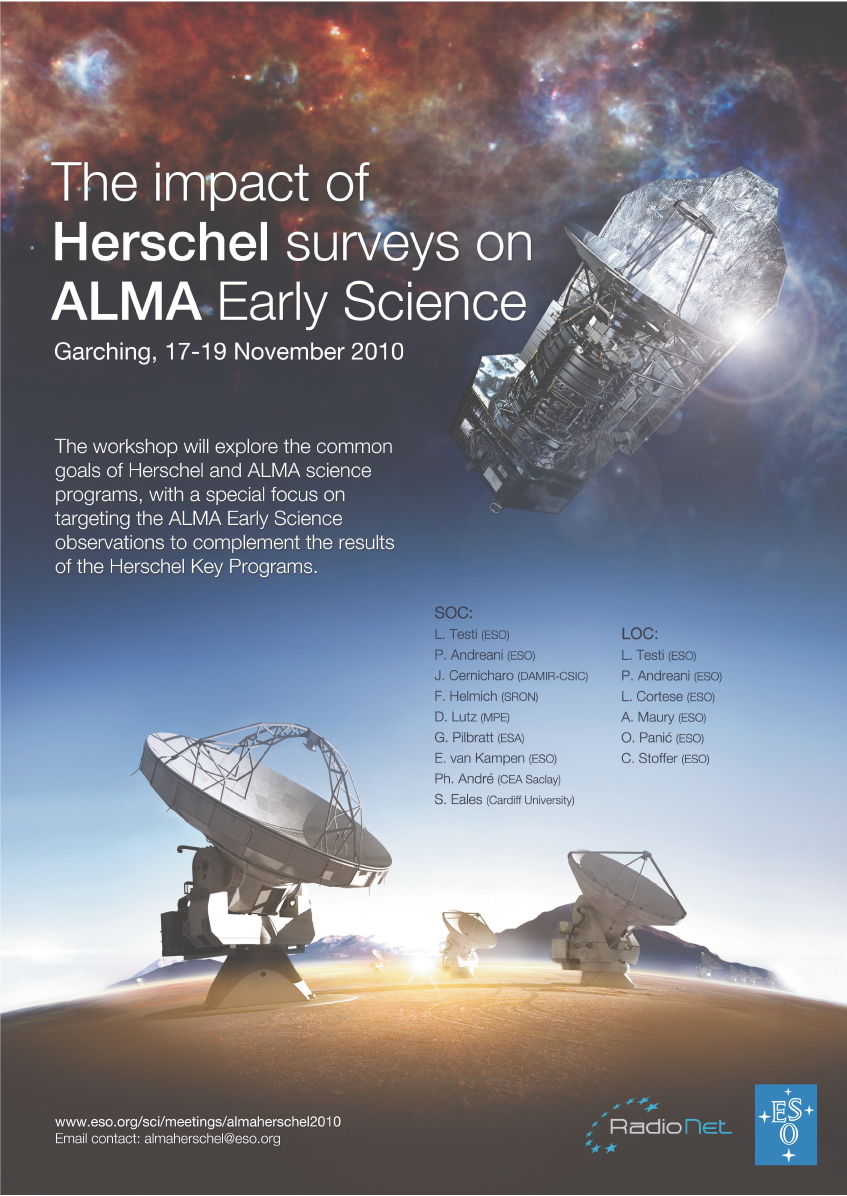The impact of Herschel surveys on ALMA Early Science
ESO Garching, 16-19 November 2010
The workshop will explore the common goals of Herschel and ALMA science programs, with a special focus on targeting the ALMA Early Science observations to complement the results of the Herschel Key Programs.
For more information contact: almaherschel@eso.org
Details of the workshop can be retrieved from the menu on the right which includes rationale of the meeting and the organizing committees .
Latest News
- January 13th: Presentations received to date have been linked to the program and list of poster papers.
- November 18th: The WORKSHOP PHOTOGRAPH LARGE / small is now available.
- October 19th: A list of poster papers is now available.
- October 13th: The preliminary program is now available.
- September 30th: The final list of participants is available.
- September 22nd: Timeframe of the workshop is available. Detailed program will follow.
- August 6th: In response to the high rate of proposed oral contributions we received, the decision was made to extend the workshop to Nov. 16 afternoon and 19 early afternoon (3.5 days against the original 2.5), so that a greater part of the interesting suggested contributions we received can be presented.
- August 1st: The registration deadline was July 30th, 2010. The registration is now closed.
Since attendance will be limited to ~80 participants, and the total number of registrations exceeded 150, a waiting list will be maintained when the SOC decision about contributions will be made.
If you did not register yet but wish to be added to the waiting list, please contact almaherschel@eso.org. - April 1st: Registration will be opened on May 1st, 2010. The registration deadline is July 30th, 2010.
First Announcement
The Atacama Large Millimeter/submillimeter Array (ALMA) will allow a great leap forward in the exploration of the 'cool universe' - the earliest evolutionary stages of galaxies, stars and planets. ALMA is currently in its scientific commissioning phase and the current expectation is to start Early Science observations in 2011.
The recently launched Herschel Space Observatory satellite, covering the spectral range from the far infrared to the submillimetre, will complete most of the Key Programme observations by the end of 2010. Herschel's exciting first results on galaxy formation and evolution as well as on the galactic star-formation and the interstellar medium are highly complementary to the science that ALMA will deliver soon. These observatories make a good combination not only in the wavelength regime, providing well sampled Spectral Energy Distributions of galaxies or the galactic young stars, but also in the angular resolution. The high angular resolution that ALMA will provide makes it the perfect resource for follow-up on the science targets observed and identified in the arcminute-sized fields of view of Herschel.
The workshop is designed to explore the powerful combination between Herschel and ALMA, taking advantage of the Herschel's first results to best exploit the ALMA Early Science call for proposals expected towards the end of 2010. We hope to foster collaborations among Herschel users and between the Herschel and ALMA communities, that will provide a coordinated action at the time of the forthcoming ALMA Early Science call for proposals. The potential for deep legacy type surveys with the completed ALMA array will also be discussed.
We invite contributions that present the scientific results based on Herschel surveys, and investigate into the exciting possibilities offered by the ALMA interferometer during Early Science. Main science topics include: Solar system; Galactic low-mass star formation; Galactic high-mass star formation; Molecular clouds; Protoplanetary disks; Local Group; Nearby galaxies; AGNs; Galaxy clusters; Cosmological background.



